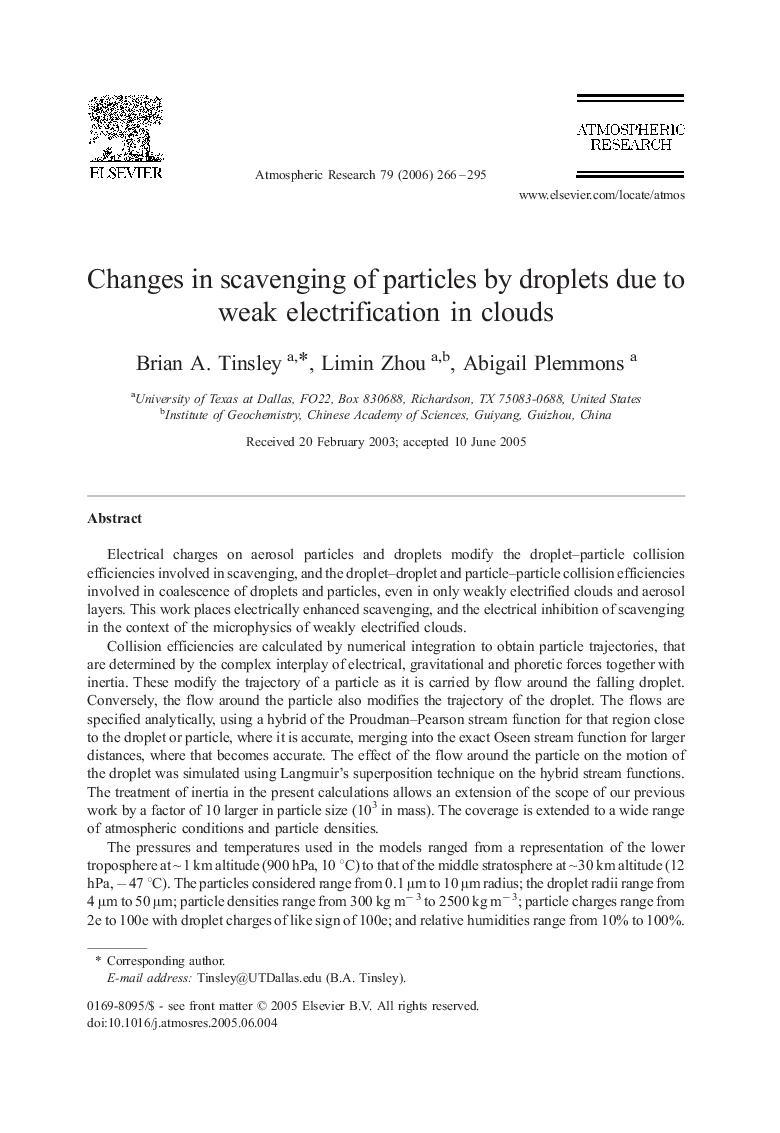| کد مقاله | کد نشریه | سال انتشار | مقاله انگلیسی | نسخه تمام متن |
|---|---|---|---|---|
| 4451584 | 1620582 | 2006 | 30 صفحه PDF | دانلود رایگان |

Electrical charges on aerosol particles and droplets modify the droplet–particle collision efficiencies involved in scavenging, and the droplet–droplet and particle–particle collision efficiencies involved in coalescence of droplets and particles, even in only weakly electrified clouds and aerosol layers. This work places electrically enhanced scavenging, and the electrical inhibition of scavenging in the context of the microphysics of weakly electrified clouds.Collision efficiencies are calculated by numerical integration to obtain particle trajectories, that are determined by the complex interplay of electrical, gravitational and phoretic forces together with inertia. These modify the trajectory of a particle as it is carried by flow around the falling droplet. Conversely, the flow around the particle also modifies the trajectory of the droplet. The flows are specified analytically, using a hybrid of the Proudman–Pearson stream function for that region close to the droplet or particle, where it is accurate, merging into the exact Oseen stream function for larger distances, where that becomes accurate. The effect of the flow around the particle on the motion of the droplet was simulated using Langmuir's superposition technique on the hybrid stream functions. The treatment of inertia in the present calculations allows an extension of the scope of our previous work by a factor of 10 larger in particle size (103 in mass). The coverage is extended to a wide range of atmospheric conditions and particle densities.The pressures and temperatures used in the models ranged from a representation of the lower troposphere at ∼ 1 km altitude (900 hPa, 10 °C) to that of the middle stratosphere at ∼ 30 km altitude (12 hPa, − 47 °C). The particles considered range from 0.1 μm to 10 μm radius; the droplet radii range from 4 μm to 50 μm; particle densities range from 300 kg m− 3 to 2500 kg m− 3; particle charges range from 2e to 100e with droplet charges of like sign of 100e; and relative humidities range from 10% to 100%.For the larger particles (radii greater than about 3 μm) interacting with the larger droplets (radii greater than about 15 μm) the effects of inertia increase with particle density and dominate at the larger densities. For particles with radii in the range 1–3 μm the ‘Greenfield Gap’ of very low collision efficiencies was found, and was determined to be due to the effects of the gravitational force causing a reduction of collisions of particles with the front of the droplet, and the effect of inertia overcoming the tendency for the weight to produce a collision in the slow velocity region in the rear. When the electrical or phoretic forces are sufficiently large the Greenfield Gap is closed.When the particles have radii < 3 μm inertial effects no longer dominate the collisions, although inertia modifies the weight effects for particles with radii down to about 0.5 μm. For charged aerosol particles with radii smaller than about 0.1 μm interacting with droplets or background aerosol particles smaller than a radius of about 15 μm, the long range electrical repulsive force is effective in opposing the phoretic forces and keeping the particle out of range of the short range attractive image force. Thus ‘electroscavenging’ gives way to ‘electroprotection’ against the scavenging or coagulation processes otherwise caused by Browninan diffusion or phoretic forces.In an atmosphere of temperature 10 °C and pressure 900 hPa the net phoretic force reduces to zero and becomes repulsive for particles with radii above about 2 μm (depending on particle conductivity). This enhances the development of the Greenfield Gap. However, the value of this radius (at which the net phoretic force is zero) increases strongly with decreasing temperature and pressure (increasing altitude) as expected from theory, and is about 5 μm in the middle troposphere and more than 10 μm in the stratosphere. Thus a net attractive phoretic force on particles extends into the 1–3 μm radius range in the upper troposphere; however, the weight and inertial effects can ensure the presence of the Greenfield Gap in that range for 2000 kg m− 3 particles up to the middle stratosphere.
Journal: Atmospheric Research - Volume 79, Issues 3–4, March 2006, Pages 266–295